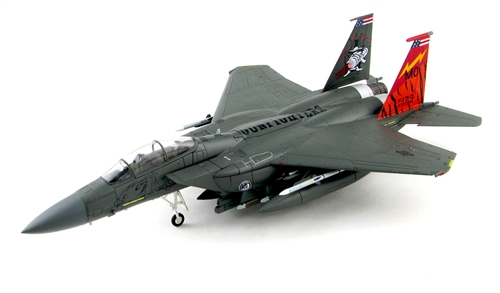Hobby Master Boeing F-15E Strike Eagle Multi-Role Fighters
Hobby Master Boeing F-15E/I Strike Eagle Multi-Role Fighters
 The McDonnell Douglas (now Boeing) F-15E Strike Eagle is an American all-weather multirole strike fighter derived from the McDonnell Douglas F-15 Eagle. The F-15E was designed in the 1980s for long-range, high-speed interdiction without relying on escort or electronic-warfare aircraft. United States Air Force (USAF) F-15E Strike Eagles can be distinguished from other U.S. Eagle variants by darker aircraft camouflage and conformal fuel tanks (CFTs) mounted along the engine intake ramps (although CFTs can also be mounted on earlier F-15 variants).
The McDonnell Douglas (now Boeing) F-15E Strike Eagle is an American all-weather multirole strike fighter derived from the McDonnell Douglas F-15 Eagle. The F-15E was designed in the 1980s for long-range, high-speed interdiction without relying on escort or electronic-warfare aircraft. United States Air Force (USAF) F-15E Strike Eagles can be distinguished from other U.S. Eagle variants by darker aircraft camouflage and conformal fuel tanks (CFTs) mounted along the engine intake ramps (although CFTs can also be mounted on earlier F-15 variants).
The Strike Eagle has been deployed for military operations in Iraq, Afghanistan, Syria, and Libya, among others. During these operations, the strike fighter has carried out deep strikes against high-value targets and combat air patrols, and provided close air support for coalition troops. It has also been exported to several countries.
The F-15E's deep-strike mission is a radical departure from the original intent of the F-15, since it was designed as an air-superiority fighter under the mantra "not a pound for air-to-ground." The basic airframe, however, proved versatile enough to produce a very capable strike fighter. The F-15E, while designed for ground attack, retains the air-to-air lethality of the F-15, and can defend itself against enemy aircraft.
The F-15E prototype was a modification of the two-seat F-15B. The F-15E, despite its origins, includes significant structural changes and much more powerful engines. The aft fuselage was designed to incorporate the more powerful engines with advanced engine bay structures and doors. The advanced structures used Superplastic forming and diffusion bonding technologies. The back seat is equipped for a weapon systems officer (WSO pronounced 'wizzo') to work the new air-to-ground avionics. The WSO uses multiple screens to display information from the radar, electronic warfare, or thermographic cameras, monitor aircraft or weapons status and possible threats, select targets, and use an electronic moving map to navigate. Two hand controls are used to select new displays and to refine targeting information. Displays can be moved from one screen to another, chosen from a menu of display options. Unlike earlier two-place jets (e.g. the F-14 Tomcat and Navy variants of the F-4), whose back seat lacked flying controls, the back seat of the F-15E cockpit is equipped with its own stick and throttle so the WSO can take over flying, albeit with reduced visibility.
To extend its range, the F-15E is fitted with two conformal fuel tanks (CFTs) that hug the fuselage. These produce lower drag than conventional underwing/underbelly drop tanks. They carry 750 U.S. gallons (2,800 L) of fuel, and house six weapons hardpoints in two rows of three in tandem. Unlike conventional drop tanks, CFTs cannot be jettisoned, thus the increased range is offset by the degraded performance from the increased drag and weight compared to a "clean" configuration. Similar tanks can be mounted on the F-15C/D and export variants, and the Israeli Air Force makes use of this option on their fighter-variant F-15s as well as their F-15I variant of the Strike Eagle; the F-15E variants are the only variants routinely fitted with CFTs.
The Strike Eagle's tactical electronic warfare system (TEWS) integrates all countermeasures on the craft: radar warning receivers, radar jammer, radar, and chaff/flare dispensers are all tied to the TEWS to provide comprehensive defense against detection and tracking. This system includes an externally mounted ALQ-131 ECM pod which is carried on the centerline pylon when required.
The APG-70 radar system allows air crews to detect ground targets from longer ranges. One feature of this system is that after a sweep of a target area, the crew freezes the air-to-ground map then goes back into air-to-air mode to clear for air threats. During the air-to-surface weapon delivery, the pilot is capable of detecting, targeting, and engaging air-to-air targets while the WSO designates the ground target. The APG-70 is to be replaced by the AN/APG-82(v)1 active electronically scanned array radar, which began flight tests in January 2010 with initial operational capability expected in 2014.
#HA4523 - USAF Boeing F-15E Strike Eagle Multi-Role Fighter - 389th Fighter Squadron "Thunderbolts", 226th Fighter Wing, Mountain Home AFB, Idaho, 2018 [Anniversary Scheme] (1:72 Scale)
|
|
|





 The McDonnell Douglas (now Boeing) F-15E Strike Eagle is an American all-weather multirole strike fighter derived from the McDonnell Douglas F-15 Eagle. The F-15E was designed in the 1980s for long-range, high-speed interdiction without relying on escort or electronic-warfare aircraft. United States Air Force (USAF) F-15E Strike Eagles can be distinguished from other U.S. Eagle variants by darker aircraft camouflage and conformal fuel tanks (CFTs) mounted along the engine intake ramps (although CFTs can also be mounted on earlier F-15 variants).
The McDonnell Douglas (now Boeing) F-15E Strike Eagle is an American all-weather multirole strike fighter derived from the McDonnell Douglas F-15 Eagle. The F-15E was designed in the 1980s for long-range, high-speed interdiction without relying on escort or electronic-warfare aircraft. United States Air Force (USAF) F-15E Strike Eagles can be distinguished from other U.S. Eagle variants by darker aircraft camouflage and conformal fuel tanks (CFTs) mounted along the engine intake ramps (although CFTs can also be mounted on earlier F-15 variants).